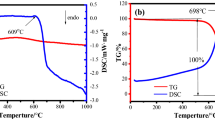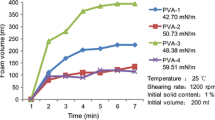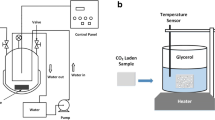Abstract
The mechanism of the surface depression of the foam glass was studied. A method of powder sintering with plate glass as the raw material and carbon black as the foaming agent was adopted to investigate the influences of foaming temperature, soaking time, moisture content in the release agent, and flame preheating temperature on the surface depression of a foam glass blank. The results indicated that insufficient cooling rate and rapid foaming process that could not react synergistically with the surface tension and viscosity of the glass melt aroused the mismatching between the glass melt and the expansion or contraction of gas, resulting in upper surface depression of foam glass. Besides, the batch carbon black at high temperature reacted with residual water in advance to generate large amounts of gas and form the air space which could expand inside, leading to lower surface depression of foam glass.
Similar content being viewed by others
References
Tian Y L, Zhou Y L, Zhao F, et al. Study on Foam Glass of High Performance[J]. Journal of Beijing Polytechnic University, 2001, 27(2): 247–250
Tian Y L, Huang Y R, Sun S B, et al. Study on Foam Glass Having Crust Layer[J]. Glass and Ceramics, 2004, 32(6): 15–18
Pittsburgh Corning. Foamglass Industrial Insulation Handbook[M]. Pittsburgh: Corning, 1992
Wu L Y, Liu L Q, Zhang J G, et al. The Technical and Economical Discussion on the Production of a New Environmental Material, Foam Glass[J]. Journal of Beijing Polytechnic University, 1998, 24(3): 115–118
Puchka O V, Minko N I, Stepanova M N. Foam-glass Based Composite Heat-insulating Material with a Protective-decorative Coating on the Front Surface[J]. Glass and Ceramics, 2009, 66(1-2): 43–45
Andre´ C B, Evaldo T K, Thiago S, et al. Glass Foam of Macroporosity Using Glass Waste and Sodium Hydroxide as the Foaming Agent[J]. Ceramics International, 2013, 39(3): 2423–2430
Francois M, Pascal Y, Martine C, et al. Characterization of Porous Glasses Prepared From Cathode Ray Tube (CRT)[J]. Powder Technology, 2006, 162(1): 59–63
Yu M L, Mu S. Preparation and Performance of a Kind of Foam Bioglass[J]. Journal of Wuhan University of Techology, 2006, 28(11): 60–62
Tian Y L, Zhao F, Zhou Y L, et al. The Technological Process and Quality Control of Foam Glass[J]. Glass and Ceramics, 2000, 28(5): 52–56
Tian Y L, Sun S B, Zhang L. The Defects of Bubble Structure in Foam Glass and Their Solutions[J]. Glass and Ceramics, 2009, 37(4): 33–36
Mear F, Yot P, Ribes M. Effects of Temperature, Reaction Time and Reducing Agent Content on the Synthesis of Macro-porous Foam Glasses from Waste Funnel Glasses[J]. Materials Letters, 2006, 60(7): 929–934
Wang C Y, Tao Y. The Problems in Foam Glass Manufacture and Solutions[J]. Glass and Ceramics, 2006, 34(6): 53–56
Zhang J B, Wu Y S. Research Development of Foam Glass[J]. China Resources Comprehensive Utilization, 2010, 28(4): 25–30
Wu Z X, Zhu S X, Li P, et al. Effect of Sintering Technology on Pore Structure of Foam Glass[J]. Journal of Functional Materials, 2014, 2(45): 2114–2118
Guo H W, Gong Y X, Liu X N, et al. Elaboration and Mechanical Behavior of High Strength Foam Glass[J]. Journal of Shaanxi University of Science & Technology, 2010, 3(28): 1–6
Luo M H. Porous Ceramics and Practical Technology[M]. Beijing: China Building Materials Press, 2006: 77–78
Zhang X F, Guo C L, Wang X L, et al. Synthesis and Characterization of Bimodal Mesoporous Silica[J]. Journal of Wuhan University of Technology-Mater. Sci. Ed., 2012, 27(6): 1084–1088
Guo Y, Zheng Y Y, Long H, et al. Intercalation of Polystyrene in Kaolin via in-situ Polymerization[J]. Spectroscopy and Spectral Analysis, 2012, 32(1): 99–102
Li X H, Jiang X P, Chen C, et al. Research on Diffuse Reflectance Infrared Fourier Transform Spectroscopy of Kinds of Kaolin in Various Areas[J]. Spectroscopy and Spectral Analysis, 2011, 31(1): 114–118
He K, Wang Y H, Zu C K, et al. Crystallization Kinetics of Lithium Aluminum Germanium Phosphate Glass by DSC Technique[J]. Journal of Wuhan University of Technology-Mater. Sci. Ed., 2012, 27(1): 63–66
Tian Y L, Sun S B. New Glass Technology[M]. Beijing: China Light Industry Press, 2011
Author information
Authors and Affiliations
Corresponding author
Additional information
Funded by National Science & Technology Pillar Program during the Twelfth Five-year Plan Period (No.2012BAJ20B02-03)
Rights and permissions
About this article
Cite this article
Tian, Y., Lu, P., Zhang, S. et al. Mechanism of surface depression on foam glass. J. Wuhan Univ. Technol.-Mat. Sci. Edit. 31, 538–542 (2016). https://doi.org/10.1007/s11595-016-1406-8
Received:
Accepted:
Published:
Issue Date:
DOI: https://doi.org/10.1007/s11595-016-1406-8




